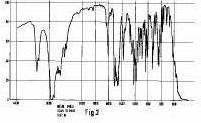Smithkline Beecham Corp. (SKB) v. Apotex Corp. (Fed. Cir. 2004)
 |
(Figure shows IR spectrum for Paxil) |
Always controversial Judge Richard A. Posner of the 7th Circuit sat as the district judge in this case. His outcome was preserved on appeal, but only after two of his holdings were reversed. This is a very well written, interesting opinion by Judge Rader. If you only read one every three-months, this should be it.
Simplification: The case involved PHC anhydrates (without water) and PHC hemihydrates (some water). In the 70’s PHC anhydrates were invented in the UK. In 1984, SKB invented PHC hemihydrates and eventually patented a PHC hemihydrate compound. (U.S. Patent No. 4,721,723) In 1998, Apotex filed an ANDA to market a prior art PHC anhydrate.
The holding is simple: 1) SKB’s clinical trials that occurred more than one year prior to filing are a public use under §102(b). The clinical trials were not a form of experimental use because the trials were experiments of the medical usefulness of the claimed compound (a PHC hemihydrate) and did not reflect upon the structure or ability to enable the claimed compound. 2) There is no room for a policy-driven inquiry during claim construction. Posner erred in adding a “commercially significant” limitation into the compound claim.
The most interesting aspect of Posner’s opinion was left for another day as moot. In his opinion, Posner created a new equitable defense to infringement that would bar enforcement of a patent when the patentee’s own conduct significantly inhibits non-infringing practice of the prior art. In this case, Apotex’s ANDA request involved making a prior-art PHC anhydrate. SKB argued that after 1984, the environment became seeded with hemihydrate crystals, and that it was no longer possible for Apotex to make PHC anhydrate that would be free of infringing hemihydrate. Under Posner’s new defense SKB would be estopped from enforcing its patent because its conduct (manufacturing hemihydrates and seeding the environment) had effectively eliminated Apotex’s ability to practice the prior art.
There is much more to this opinion including a thought provoking concurrence by Judge Gajarsa.
Read Part II, Part III, and part IV.
Here is a link to Judge Posner’s Opinion. (Thanks Howard Bashman)
SmithKline Beecham v. Apotex
(Part IV)
In an updated concurrence, J. Gajarsa adds firepower to his disagreement with the newly defined experimental use exception: According to the majority, SKB’s testing of PHC’s performance as a human antidepressant was not necessary to reduce PHC to pra…
SmithKline Beecham v. Apotex
(PART III)
SmithKline Beecham v. Apotex: The concurrence. Judge Gajarsa filed a Concurrence in SKB based upon his sua sponte analysis of Section 101. SKB had argued that its claimed compound (PHC hemihydrate) had been seeded in the environment and, once seeded,
SmithKline Beecham v. Apotex
(PART III)
SmithKline Beecham v. Apotex: The concurrence. Judge Gajarsa filed a Concurrence in SKB based upon his sua sponte analysis of Section 101. SKB had argued that its claimed compound (PHC hemihydrate) had been seeded in the environment and, once seeded,
Comments are closed.